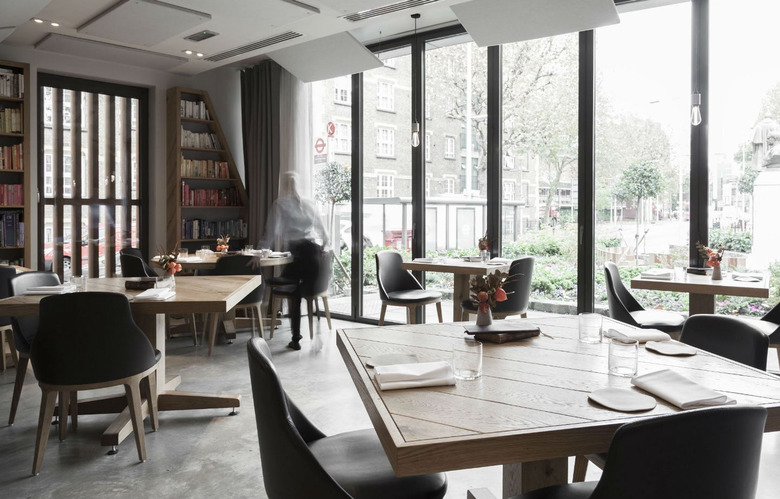Restaurant Story: An Impressive Modernist Addition To The London Dining Scene
I just visited a very different kind of place: Restaurant Story in Bermondsey (where Tooley Street meets Tower Bridge Road). I'll mention, just to puff out my cavernous grasp of history, that the site used to be a public lavatory, but you shouldn't place much store by that. The Victorian building has been razed, replaced with a 40-seat Scandinavian-inspired glass-fronted edifice that could be the sub-branch of a public library or a lakefront summer house. The restaurant contributed funds to the public park out the front, making for a view that holds the traffic at arm's length. Nor should you expect forced jokes about the former use of the site in the decor or the menu. No eating compote out of a chocolate commode or Duchamp urinals stuffed with vegetables. The past is expunged in favor of an uncompromising modernist approach to the menu, a (much overlooked by commentators) focus on local sourcing, a deeply personal beverage list by head sommelier Patrick Frawley, and a recurrent theme of the courses of the meal being like the chapters of a book.
The one Michelin starred brainchild is from 29 year-old Tom Sellers, who started in a pub kitchen in his hometown of Nottingham. One day he turned up on Tom Aikens' door asking for a job (I would love to ask him, of all the star chefs in London, why Tom Aikens?). He worked there for two and a half years, rising to chef de partie. At 19 he 'crossed the pond' to Per Se where he worked under Thomas Keller. Two years later it was back to the UK to be sous chef under Adam Byatt at Trinity in Clapham for three years. Byatt impression of Sellers is evident from the fact that he is one of four owners of Restaurant Story (the others are Sellers, and two property developers). After that followed a year at Noma in Copenhagen, under René Redzepi, before returning to the UK and a few filler gigs (including TV) while organizing what became Restaurant Story. Quite a resume. But whose influence out of this quadrumvirate will prevail on the plate?
A copy of a Dickens novel is removed from our table and we are brought menus. They might as well be the Chinese GDP numbers, in terms of their explanatory power. 'Foreward' is snacks. 'Chapter 1' is Sea. 'Chapter II' is Childhood, with each chapter followed by a terse description (usually just one word) of the dish that follows. So chapters are themes, and contain one or more courses. Sea is 'razor', followed by 'crab', for example. There are eleven courses total so small plates (Keller) are the order of the day. The menu is set (£80), other than for dietary requirements.
Snacks jolt us into preparedness for what is obviously going to be a memorable meal. First, wafers of crisped cod skin, dotted with whipped cod roe and gin botanicals (Redzepi). Each of us gets a couple of mouthfuls, but I get murmurs of agreement when I suggest that one could make a whole meal out of these. Then, what looks like an Oreo cookie, but is actually a savory bread filled with Rabbit rillette. It is divine, and delivered as a small package that leaves us craving more. Then nasturtium flowers stuffed with oyster mayonnaise. I knew that nasturtiums had a purpose as these go down so easily.
For 'Childhood' we get Bread and Dripping. A candle, made from dripping, is lit and, as it melts, guests are invited to dip poppy seed sourdough bread in it. Tasty and clever. Raw scallop is sliced thinly, and served with balls of cucumber and dill ash. Modernism rescuing what I thought was an ingredient so pervasive that it could no longer evoke interest.
Chapter III ('Land') started with Heritage Potato. A rich dollop of mash with a smidgen of turnip on a dense black sauce named 'coal'. This is followed by Herdwick lamb.
Even in the parsimonious quantities served, we are now filling. Dessert (AKA Chapter IV 'The End') brings Almond and Dill. A dessert spoon sized quenelle of almond ice cream with almond snow and dill snow.
The drinks pairing (£60) is recommended and includes spirits and beer as well as wine. It turns out Patrick Frawley is something of a local beer expert and serves Anspach & Hobday 'The Smoked Brown', brewed within (healthy) walking distance. Asked about the craft beer boom in Britain he informs me that it has reached the pitch where there are no fewer than 20 breweries within 10 blocks of Tower Bridge. I took advantage of the Bermondsey Beer Mile, albeit the next Sunday, when most breweries are closed, rather than busy Saturday. Recommended.
All the dishes are telegenic tours de force (Aitken) which makes it sad to only eat them (if only Steven Hawking had solved the problem of "having one's cake and eat it too"). The whole four hours is an unforgettable experience. Sellers is one of the chefs keeping the momentum in modernist cuisine, something that is welcome in a world of 'same and simple'.
We left full, but not stuffed. And more ready and happy to walk down Tooley Street to Tower Bridge station than we were when we came.
